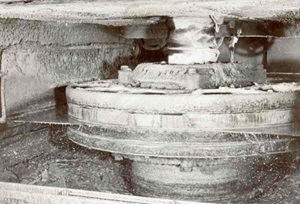Plate process
 There were three main stages of the Plate process:
There were three main stages of the Plate process:
Molten glass is rolled to create a flat plate of glass
This stage could be done on a table with a mobile roller which would be manually rolled across the surface of the molten pool of glass to flatten it while it hardened, or the molten glass could be sent through two rollers to create a continuous ribbon of glass. The rollers in this stage would leave the surface of the glass rough and marked, so would be opaque after this stage.
Plate is ground down to create two parallel surfaces
The plate of glass is then ground to create a smooth, unmarked surface. In the early designs of this stage each surface would be ground separately, making this a very time-consuming process. Pilkington developed the Pilkington twin grinder (pictured below) which could continuously grind both sides of the rolled sheet of glass, speeding up the process. This would ground around 20% of the glass off the surfaces as sand which would end up in landfill.
 Plate is polished to create a transparent, distortion-free product
Plate is polished to create a transparent, distortion-free product
This final stage would finally leave the glass transparent and distortion-free which was the desired result. Similarly, to the grounding stage, in the early designs of plate glass production, this polishing would be done at one surface at a time.
Information sourced from The Glassmakers by T. C. Barker and Float: Pilkingtons' Glass Revolution by D. J. Bricknell and in-house.